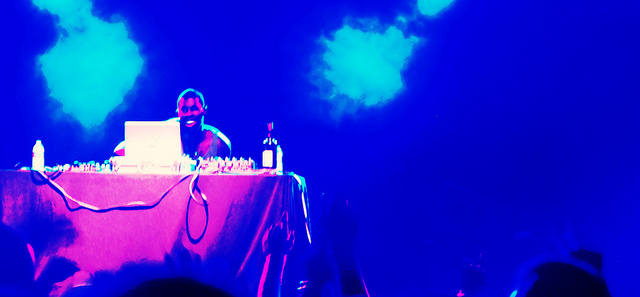In Defense of the Laptop Record
Many studio veterans maintain a certain stigma against “laptop records.” By laptop records, I mean recordings that are made outside of a traditional recording studio, without a collection of expensive analog gear. They are sometimes demonized in discussions during down time in pro-level sessions, even though many of them exhibit a higher level of artistry than professionally produced records. I would like to see this stigma dismantled.
People like Dave Grohl and Neil Young have taken to championing a belief that the “authentic” way to make records is live, on a console, to tape. While this is certainly a great way to make a record, I will argue that it is oftentimes not the most authentic way to do so.
Of course, there is a kind of authenticity in allowing the performance to be heard for what it is (which is what I assume Grohl and Young are talking about) but there is also authenticity in making a record that you believe in despite the fact that you can’t afford access to a vintage Neve, Studer, and a well-treated recording environment. Trying to convince artists that they need a premium level of gear to make their art is doing a disservice not only to the artists, but to the music world itself.
Real musicians make music under any circumstances, and they don’t have a lot of disposable income these days. Most records by new artists would turn out better—from the perspective of both budget and end product—if the artist were to complete a large portion of the process at home, given the technology that is so inexpensive and readily available today.
Older studio gear is more expensive than the newer tools. Because of this, purchasing new technology instead of vintage gear is very different than springing for a shiny new car over a used one.
In recording, it’s the new technology purchases that usually stem from economic necessity. An old, beat up vintage console is a luxury, and a new Mac Pro is the value buy. It’s an inversion of what has been typical in the pricing of recording technology in the past, and it suggests that it’s about time we change the way that the gear used in the recording process affects our perception of a recording’s authenticity.
Few among us can afford access to a collection of classic gear for any length of time, but many of us can save enough money to purchase a decent Mac mini and a UAD Satellite reasonably quickly. Together, they cost about as much as just one day at a studio crammed full of such prized vintage equipment. And yet, some studio veterans continue to paint the vintage classics as the gear that you need to use in order to be considered a “real musician.”
The likelihood of a label or other organization investing in an artist they’ve made something worth hearing is slim to none. And, if a great laptop record gets picked up by a label it will likely pass through professional mixing and mastering engineers eventually. Without the sufficient time to make the record great to begin with, though, the chances of it going anywhere are basically non-existent.
If we in the professional recording community want to be useful—to do our jobs in a way that helps great records get made—we need to champion artists who are willing to do whatever it takes to turn their ideas into WAV files. Real, working class musicians are using Macs and plugins, while white-collar folks end up being the only ones who can afford 70’s style recording. The schema for the authentic recording artist is no longer the troubadour in front of the Neumann; it is the hipster in front of the laptop.
We must ask, then—why is this happening? Why are we disparaging what are probably some of the most authentic recordings being made today? The obvious answer is fear: Fear that our jobs will become obsolete.
This is by no means an unjustified worry to have– production tools are now accessible enough for new artists and producers to get dramatic and impactful results without much engineering experience at all. But, while this may lead to fear of closing our studios (and perhaps spark overly enthusiastic justification of our gear’s worth to our clients) we must always remember one thing about laptop production: IT IS A TREMENDOUSLY GOOD THING!!!

Some artists, like Flying Lotus, turn the laptop recording into an art form of its own. Image by Flickr user Jon Elbaz
Artists and producers now have more control over their vision than ever before. This is the real benefit and drive behind all innovations in recording.
Technological advances may end or alter existing jobs, so it should be no surprise that the established professional’s role in the process will be different, but we don’t need to fear this natural progression. The relevant technological advances here truly are advances for everyone involved.
If we are not needed for a certain part of the process on a given project, then we shouldn’t waste our time trying to falsely convince a client that we are. Authenticity gets lost when we try to do that—not when a young musician fires up GarageBand.
“Adapt or die” is a familiar sentiment, but it is often misunderstood. It does not just mean “learn the new tools or people will not work with you,” it means “if you find a great artist, adapt the process to their needs and their means.” That is the job of today’s producers and engineers.
The way many studio veterans do this is to try to cram more songs into less time at their incredible studio. Sometimes that works just fine (especially for basic tracking, and especially for veteran artists who are very well-rehearsed). Other times, the record would have been better if the artist had more time to work on her own. One problem is that since there is no way of telling what a record would have been if a different process had been used, studio owners will often try to convince the artist (and themselves) that the option where their studio gets to bill for the most time will definitely, without a doubt, produce the best product. Hey, they’ll never know if that’s not the case, right?
We should not be doing this. If you have the opportunity to work with a great artist and they can only afford a laptop record at this stage in their career, then figure out how to help them make a great laptop record! (Maybe even start investing your own resources into great musicians and not just into studio toys. Studio owners note: investing in musicians is just as tax deductible as investing in gear, and working on great music is likely to earn you a lot more in the long run than owning a few more fancy rack units.)
It’s important to note that many records today are hybrids of the ”pro studio” and “laptop” models, and this is usually an advantage. One popular plan is to track drums in a commercial studio and finish the rest of the recording process at home. The issue here is that while musicians are usually aware of how much a professional studio can bring to their music, professional producers and engineers often underestimate what musicians can bring to their own productions.
In my experience, if you give an artist time to lose herself in her laptop and headphones, good things happen. There will usually still be areas where we have skills that an artist may not possess, and it is part of our job to recognize each artist’s production potential and let them realize it, while also identifying the areas where we can help.
When we are truly helping artists actualize their art, our advice becomes valuable, our clients return to us, and better records are made. So let us do what we entered this industry to do: facilitate the creation of the best records possible. And let us not forget that in many cases this means encouraging, rather than discouraging, new artists who want to make records on their laptops.
Please note: When you buy products through links on this page, we may earn an affiliate commission.









Supercapital
March 19, 2015 at 12:41 pm (10 years ago)I love my ITB system but I miss the big 5 person mixing sessions.
I also miss big old analog boards at concerts. Live sound is much easier that way, except the saving and routing 🙂
nottooloud
March 19, 2015 at 1:30 pm (10 years ago)Totally agree, with one minor quibble over “a kind of authenticity in allowing the performance to be heard for what it is (which is what I assume Grohl and Young are talking about)”. I’d say heard for what it sounds like through a console onto tape. The gear they champion colours the sound in many ways. Current methods can produce a far more accurate reproduction of what actually came out of the microphone.
WW4
March 19, 2015 at 2:48 pm (10 years ago)Laptops are the Portastudios of today–just with a slightly higher learning curve, way more options and typically better quality. I learned how to arrange music, and in some ways, to mix, working in a portastudio. And laptops are so collaborative: give your friend a thumb drive/zip file/CD of the last session and she can cut tracks at her place and convenience and bring them back the next week. For writing music, it’s hard to beat.
I do crave the quality and nece$$ary finality of professional studio recording sessions. But then, one common way to work is to cut basic tracks at a pro studio and take the tracks home for overdubs. The flexibility is really astounding compared to even 15 years ago.
When I hear music that moves me, caring about how it was recorded is maybe my 10th or 12th thought. Everything is relative: a good laptop recording will often sound better than an all-analog professionally-recorded album poorly mastered in the early 90s for CD, for example.
DGuitar
March 19, 2015 at 8:49 pm (10 years ago)Computers are ruining the music business like everything else. Soon you wont need musicians, the computer will do it for you. In the 60s, 70s and 80s I was turning gigs down, now gigs are far and few between, unless you want to play for free. We need to keep LIVE MUSIC ALIVE!!!!
Mikal A. Muhammad
March 19, 2015 at 11:32 pm (10 years ago)I must say, I have to agree.
pschase
March 20, 2015 at 11:14 am (10 years ago)Great article, if even only for conversation sake. I fully agree that studios should embrace the “bedroom producer” and further, I think bedroom producers can gain by making the local studio part of their process. For example, I’m not in a regular band right now, so I can create “sound beds” at home, high quality demos of ideas. Then I get a block of time at a local studio, and jam on the ideas with friends who are good, open players. There’s always something good in these sessions, and I end up with well recorded versions to catalog.
I love the instant creative access that home recording affords, but it’s also good to step away and be creative while a pro runs the board. Let’s get freaky..show me how to run my laptop out thru an amp, like any other synth / guitar, and sound great! With a midi control, it’s just another instrument.
It’s all about scene, community, as corny as that may sound nowaday. The current industry model has somehow convinced the music loving masses that music is a product that they present to the people, the streets. But the truth is that music works from the underground up to the companies. It’s the studios, the rehearsal spaces, the venues and bars, the neighborhoods that create this stuff that goes on to generate billions, and change lives.
So, musical people, get busy at home and when you get some extra cash, support your local studio. Even digital gear can cost as much as a $400 block of time at a studio. I’d take 8 hours of time at a good, vibey studio over an iPhone6, personally
DPrty
March 22, 2015 at 8:50 pm (10 years ago)Computers have made the music business better. It is now assessable to everyone. Its not about gigs anymore its about what you can do on the web. Adapt or die.
DPrty
March 22, 2015 at 9:17 pm (10 years ago)Agreed. That’s why SonicScoop should do more Bedroom Producer centric articles instead of focusing on large studios.
Elle
March 26, 2015 at 8:41 am (10 years ago)Oh thank goodness. I was hoping someone would think that. While I want to perform live very much, I’m not a normal, fully abled adult person. I’m a very petite (so it’s scary out there) diff-abled woman who cannot drive (well or fear-free, so I didn’t finish learning) and wouldn’t afford a car anyway. I depend on very few loved ones to help. It’s not so easy for me to be out in the normal world, but then again, I wouldn’t be me without computers or the Internet anyway. I even exclusively dated from online!! (I’m done “just” dating, yes, well knock on wood!! ;))
Anyway, I’m sure gigging will work eventually but the “local band,” “local scene” attitude persisting bothers me, even though I looooove my home area, I just mostly live on the Internet, while eating local food, haha. I occasionally even see local weather. Ha. OK my life is just temporarily more hermit-like than usual because my S.O. is very busy with exam prep, and like I mentioned, I need rides to go anywhere. Sadly, he doesn’t work near the subway system, so we can’t live there. We also don’t live within 40 minutes of family or friends (I hate trying to make new friends; I’m a … pet person).
The thing is, can’t modern music folks admit we are getting to a point where the Internet can replace a “local scene” for some artists? Not just supplement, which some ignore, but replace, if the artist needs or desires?
What about the artists in remote areas? “Severely” disabled artists? Hmm?
“Because the Internet” is more than a Childish Gambino album! 🙂 It’s life for some! Mike from Idea Channel says the Internet is his hometown and I’m with him (and, at heart, Boston, though unfortunately I’m residing more in the middle of the state now, which is actually really different – and more rural – than my eastern home!).
Bruce
April 5, 2015 at 3:56 pm (10 years ago)I’ll try to stay on topic here as the article is about “laptop” v. “conventional” studio recording. The real difference is access to “sound”, as opposed to “audio,” tools. Conventional studios gives you access to quality transducers to get the audio into whatever recording system you prefer to mix on. Also, depending on your product, the CS (Conventional Studio) will have quality transducers on which to mix—do you always want to rely on your headphones for your mix? These transducers, microphones and speakers, cost several times what your laptop/software did. It’s much more economical to rent studio time when you need access to them. So the hybrid approach mentioned in the article seems to be the way to go.
I do find it interesting the way the comments here have turned. I think the bigger question is the business model and economic viability of recorded music. The real money, living wage, music model seems to have dramatically leaned towards “live” performance. Perhaps we are seeing a return to a time when record(ing) sales were driven by a remembrance and selling of a live performance rather than being a profitable product on its own.
Chuck Hughes
July 8, 2015 at 6:08 am (10 years ago)The internet is now better than the local scene. You have the whole world from which to attract your followers. Local live gigs are paying the same as they did 20-40 years ago. Three people at your local venue might want to hear Psychobilly, but worldwide, it is easy to find 30,000.